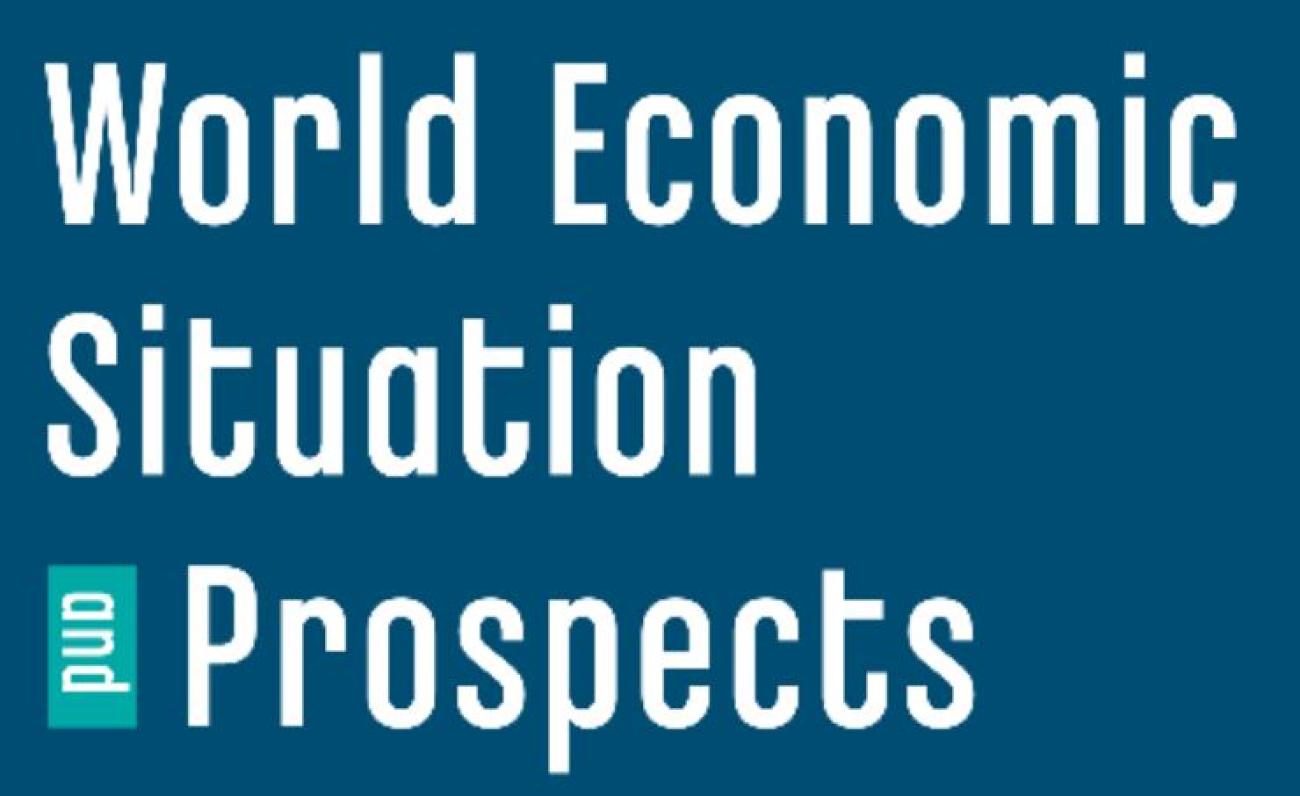COVID-19 impact on the global economy and the implications for Namibia and Southern Africa

World Economic Situation and Prospects as of mid-2020 report
Against the backdrop of a devastating pandemic, the global economy is projected to contract sharply by 3.2 per cent this year, according to the United Nations World Economic Situation and Prospects (WESP) mid-2020 report, released on 13 May 2020.
In interviews held with media houses in Namibia, Eunice Ajambo, Economist and Development Coordination officer for the UN in Namibia provided an overview on the main points as underscored in the WESP.

Caption: Eunice Ajambo, Economist and Development Coordination Officer, UN Namibia
Ajambo said that the WESP is being released at an unprecedented time in world history,
“It is being released at a time when COVID-19 has paralyzed large parts of the global economy, restricted economic activities, where we are witnessing increasing uncertainty.” COVID-19 has unleashed a recession unseen since the Great Depression in the 1930s, the report’s release is at a time where the economy, is experiencing a slump similar to the recession in 1930. This presents a significant challenge because the global economy we know today is very different from the global economy we knew in 1930.
“Today we are much more interconnected and interlinked, in a highly globalized world. So, facing the COVID-19 pandemic really presents a need for creativity in instituting forward-looking policy measures that can help with the response and recovery from this pandemic,” Ajambo said.
During the interviews, Ajambo touched on the key messages of the WESP that are highly significant for Namibia and the Southern African Region.
The global economy is expected to shrink by 3.2 percent in 2020
It is projected that that the global economy will shrink by 3.2 percent and in the coming two years we expect an estimated 8.5 trillion dollars of global output to be wiped out. For illustration purposes, Ajambo referenced the economies of Germany, United Kingdom and France, citing that these countries’ combined economies would be lost to the global economy in the coming two years as a result of COVID-19. “The other way to look at it is to think of the economies of Italy, Brazil, Canada, India and France, their combined economies being wiped out in the coming two years,” she went on to say. Besides the shrinkage in the world economy there is also the expectation of a decline and a contraction in world trade by 15 percent in 2020. “If we agree that global trade is valued at an estimated 20 trillion USD annually, then 15 percent of that is being projected to be lost in 2020 as a result of COVID-19,” the UN’s Economist illustrated.
What are the implications for Namibia and the Southern African region over a projected shrinking world economy in 2020?
Ajambo said that the implications for Namibia are significantly tied to the main channels through which Namibia’s economy is exposed to as a result of COVID-19, and it also applies to the sub region as well.
There are three main channels through which countries are exposed to COVID- 19, namely, commodities, tourism and trade. With the shrinking global economy, the demand for primary commodities (minerals in Namibia and the sub region) is expected to decline. Countries in the sub region that trade significantly with the European Union (EU) and China have been severely impacted by COVID-19, and there is also a lower demand in the EU and China which causes lower demand for trade from Namibia and the Southern African region. The third channel is through tourism; with 90 percent of the world’s economy being locked down, what we are witnessing is a stagnation and negative numbers in the tourism receipts of countries that rely on this as a major source of revenue and foreign exchange earnings. So, those are the implications of a shrinking world economy.
Related to that, the absence of economic activity is the heavy toll on jobs and incomes worldwide, as we’ve seen already a lot of people are not going to work. As 90 percent of the world economy is under lockdown and unemployment rates are projected to soar worldwide it is estimated that 30 million jobs will be lost in larger countries such as the USA.
With a shrinking world economy, we are seeing a toll on jobs and incomes and unfortunately the lockdowns are hitting sectors such as transportation, travel, retail and hospitality. These are really the hardest hit sectors and as we know, again linking to tourism, without travel, without hospitality, those receipts are really impacted and the country does not benefit significantly from them. With a declining income, a drop in jobs, Ajambo foresees and expect increased levels of poverty and inequality. For this year alone, the projection is that 34.3 million additional people will face extreme poverty and of these 34.3 million people, 56 percent of the increase will be in the African region.
Ajambo says that food for thought for Namibia to reflect on is, if the global economy is shrinking, if we’re losing jobs and income is declining, poverty is going to increase and so will inequality. She says that this was already predicted by the Government, so as a solution, which is the third key message of WESP focuses on the measures that governments have taken to address some of the repercussions and impacts of COVID- 19 on lives and livelihoods.
We are witnessing a surge in fiscal measures across the world in order to cushion the most vulnerable, to cushion the populations that are most threatened but also to mitigate the effects of the lockdowns in health and on the economy as a whole. Within the Southern African Development Community (SADC) region for example , majority of SADC countries have instituted some form of a measure to deal with COVID-19. “Namibia is highly commended for the fiscal stimulus and relief package of 8.1 billion NAD that was instituted to mitigate the effect of COVID-19 on the health sector, households, and businesses.,” Ajambo says.
“As it turns out Namibia’s stimulus response package is one of the most generous within the SADC region, for comparison purposes,” she added.
Stimulus packages range from over 10 percent of GDP in the more developed countries to below 1 percent of GDP in developing countries. Namibia is in the middle, having instituted a stimulus package of an estimated 4.25 percent of GDP, a commendable effort in the sense of having predicted the upcoming susceptibility of falling into poverty and increased inequality, the government took on this measure which is a positive and which places Namibia in a special and commendable position.
Unfortunately, these financial resources must emanate from somewhere whether it’s borrowing, grants or from reserves, somebody has to pay for the stimulus packages and so the other key message coming from the WESP is that developing countries are unfortunately facing significant constraints in implementing sufficiently large fiscal stimulus. This is as a result of the decline in external flows from exports and tourism revenues and also the impending issue of a debt distress. “I think this is the concerning issue for Namibia, which is that , a stimulus package has been released but then how are those finances going to be handled, and what fiscal sustainability measures have been put in place to ensure that the country doesn’t fall into debt distress,” Ajambo said.
This implies that liquidity is unfortunately not enough in the long term to cushion economies from the shock of a crisis. and imagine Adding liquidity into the economy from a still significant package is a short-term solution and should be a temporary measure. For longer term sustainability and resilience, the WESP calls for boosting in productive investments and looking at how can we build the resilience of the economy so that when the next COVID-19 pandemic occurs, we are able to sustain ourselves. Ajambo stated that this is the opportunity being presented to Namibia right now. In 2020 the global economy is going to shrink but in 2021 the projection is that it is going to rebound. “So what are the measures, what are the strategies that are being put in place or being explored to ensure that an overhaul of the economy is being undertaken and that resilience are for the long term through economic transformation is being built and can be sustained,” she adds.
The UN contribution
The UN System contributes to the effort of a recovery and resilience building response of countries.
“What we are advocating for and offering support to the government is through measures that are along five pillars and that we think that if implemented given the context of each country that they could contribute someway to building resilience in addition to this immediate response,” Ajambo says.
These measures are also anchored by the principals of “leaving no one behind”, thinking about the most vulnerable in our community, the high-risk populations, the informal sector, the unemployed youth, and unemployed women and communities in rural areas as well as young girls. The recovery and response measures that the UN is proposing are hinged on principles of inclusion, and resilience and sustainability to ensure we don’t fall behind in our efforts to contribute towards the achievement of the Sustainable Development Goals (SDGs)
The five pillars
The first pillar, health, it’s first and foremost a health crisis, we need to ensure that essential health services are available. The 2nd pillar is on protecting people. Social protection and offering basic services, ensuring that there is enough essential food and nutrition services, ensuring continuity of water and sanitation services. Sustaining learning for children and adolescents and then of course supporting victims of gender based violence. The Third pillar is on economic recovery and response, protecting jobs, supporting small and medium sized enterprises, informal sector workers, and all other marginalized and most vulnerable populations. The fourth pillar is on the macroeconomic response and multilateral collaboration. The macro economic response is highly significant because the macro economic situation prior to COVID-19 has an effect on the recovery options that are available to the country going forward . So that is an element of what we need to be thinking about , what was the baseline in the macro economic situation , where are we now and what are our options going forward. Multilateral collaboration is really the point that COVID-19 response requires most, bringing everyone around the table as there is no way that any single country can reposed and recover from the pandemic in isolation. The 5th pillar is on social cohesion, and community response. What the WESP is doing for Namibia is that it confirms a significant number of lessons that we already know on the need to institute measures in order to mitigate some of the direct and indirect effects of COVID-19, but also being weary of the effects of whatever chosen policy option might be.
“Economic transformation is a must,” Ajambo concludes.
Lastly, the UN system in Namibia is contributing to the efforts of the government in addressing some of the short-term, medium-term and long-term effects and through a multi -stakeholder approach.
*The World Economic Situation and Prospect Report, a report released at mid point 2020. It is an annual report of the UN on the world economy by UNDESA and UNCTAD and five regional commissions, including the UN Economic Commission for Africa.
Written by



















